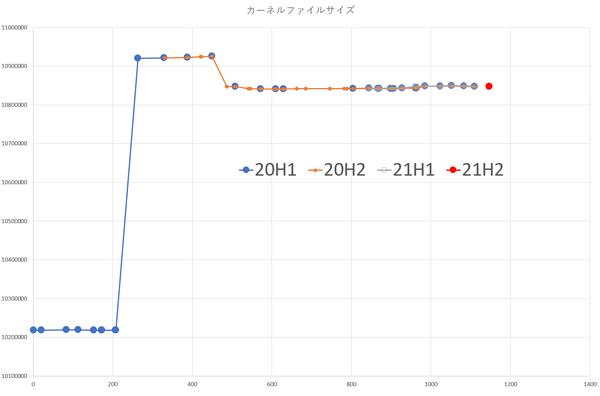Windows 10 will be updated this fal...
26
12
Windows 10 will be updated this fall, but is it small this time? 21H2 preview started
On the Release Preview Channel of the Windows Insider Program, distribution of the preview version of Windows 10 Ver.21H2 (hereinafter referred to as 21H2) has started. The build number is 19044.1147. In other words, this fall's update is also a minor update. Windows 11 will appear within the year, so I thought it would come with the kernel etc., but it seems that VB_Release will continue from 2020, and this fall will also use high-speed updates.
Windows 10 Ver.21H2 preview started
WSL2 is the only major new feature in Windows 10 21H2? This autumn's update is likely to be functionally small
According to Microsoft's blog, the following three new features will be introduced in Windows 10 Ver.21H2.
・Support for Hash to Element (H2E) included in WPA3 for wireless LAN・Windows Hello for Business simplified passwordless deployment model・Support for GPU computing for WSL2
Wireless LAN H2E support corresponds to the update of WPA3 at the end of last year. WPA3 achieves higher security than WPA2, but problems have been found, and WPA3 December 2020 Update was formulated as a countermeasure. This feature is required to connect to WPA3 access points that support this update. "Windows Hello for Business" is a feature for companies, so I won't explain it here.
These are a little too small to be a feature of 21H2. 21H2's biggest update, after all, will likely be GPU support for WSL2. There have been four new features of WSL2 that have been previewed in the Windows Insider Program Dev Channel so far. One of them is "GPU Computing Support" and the other three are "External Storage Mounting", "Nested VM Support" and "WSLg". Both have been dealt with in the past in this series, so I won't explain them here. Please refer to the article below.
GPU Computing Support
●Install CUDA on WSL on WSL2 https://ascii.jp/elem/000/004/020/4020410/●GPU can be used from WSL2 on Windows 10 Now https://ascii.jp/elem/000/004/019/4019541/
Mounting external storage
●WSL2 can now mount external storage https://ascii.jp/elem/000/004/026/4026714/

Nested VM support
Use the latest build of Windows 10 and use a virtual machine environment with WSL2 https://ascii.jp/elem/000/004/039/4039729/
WSLg
●The mechanism of "WSLg" that runs GUI applications on WSL2 https://ascii.jp/elem/000/004/054/4054049/●Support for GUI applications on WSL2 Started with the preview version I tried to run it https://ascii.jp/elem/000/004/053/4053659/●WSL2 uses RDP to display a Linux GUI application window https://ascii.jp/elem/ 000/004/041/4041422/ ● WSL2 for Linux GUI applications https://ascii.jp/elem/000/004/040/4040474/
Although these functions are supported by Windows 11, 21H2 has not announced "External storage mounting", "Nested VM support", or "WSLg". The functions were actually implemented in "FE_RELEASE" and "CO_RELEASE" distributed in the Dev Channel of the Windows Insider Program.
| When | Release name | Build number | Remarks |
|---|---|---|---|
| From 2019 | VB_RELEASE | 18836-19041 | Windows 10 Ver.2004 |
| January 2020- | MN_RELEASE | 19536-19645 | |
| June 2020-< /td> | FE_RELEASE | 20150~20279 | WSL2 GPU support, external storage support |
| From January 2021 | CO_RELEASE | 21277-21390 | WSL2 NestedVM, WSLg |
| June 2021- | td>(Windows 11) | 22000.51~ |
After all, Windows 10 What's inside 21H2?
Here, let's summarize the relationship between the Windows 10 release version and preview version from last year, and Windows 11. Windows 10 Ver.2004 in the spring of 2020 was based on a preview version called "VB_RELEASE".
The Windows Insider Program's Dev Channel preview version is released every six months, and after the VB_RELEASE in the first half of 2020, the release was switched every six months on the Dev Channel with MN/FE/CO, but the official The version of Windows has been based on VB_RELEASE since 2020 Spring 20H1. So MN/FE/CO were previewed but not released as Windows 10.
While only some of the features that were previewed were included in the official release, most of the features remained as previews. This is probably because the new function depends on other Windows modules such as the new kernel, and could not support VB_RELEASE.
The image below shows the kernel size of the update from 20H1. The kernel size of this 21H2 preview version is almost the same as that of 21H1. In other words, the core part seems to be based on Windows 10 Ver.2004 (OS build 19041) that appeared in the spring 2020 update. The build numbers from 20H1 to 21H2 have only increased by one from 19041, so it can be inferred that there are no major changes.
Kernel file size for Windows 10 20H1 (Ver.2004) to 21H2. Windows 10, which was updated at the same time, has the same kernel size even if the version is different. Among them, the kernel size of 21H2 is almost the same as 21H1
According to Microsoft's blog, the new features planned for 21H2 are not included in this preview. At present, it is highly likely that it is based on 21H1 with only minor changes. In fact, in the past, the first preview versions were often pretty much the same as the official version.
Also, in WSL2 of Windows 11, the Linux kernel version is "5.10.43", but in the 21H2 preview version, the latest version is "5.4.72", which is the same as the current version of Windows 10 (21H1). I will report the status. Probably because WSL2 itself is different.
On Windows 11 (note the version number at the top of the console), WSL2 uses kernel 5.10.43
In the preview version of Windows 10 Ver.21H2 (the version number at the top of the console), the WSL2 kernel is 5.4.72, unlike Windows 11.
For the time being, there seems to be no doubt that this preview is almost the same as 21H1. It will be the preview after the next time that it will actually be like 21H2.
And 21H2 is also considered a minor update like 21H1 and 20H2. That said, there are more than a few bug fixes each time, so it's a step forward in terms of stability. If this condition continues and minor updates continue, future Windows Updates will only require a few minute reboots once a month, and the PC may not be inoperable for a long time.
If that is the case, Windows 10 users will finally be able to enjoy "comfortable days" without being disturbed by Windows Update.








